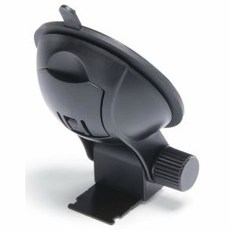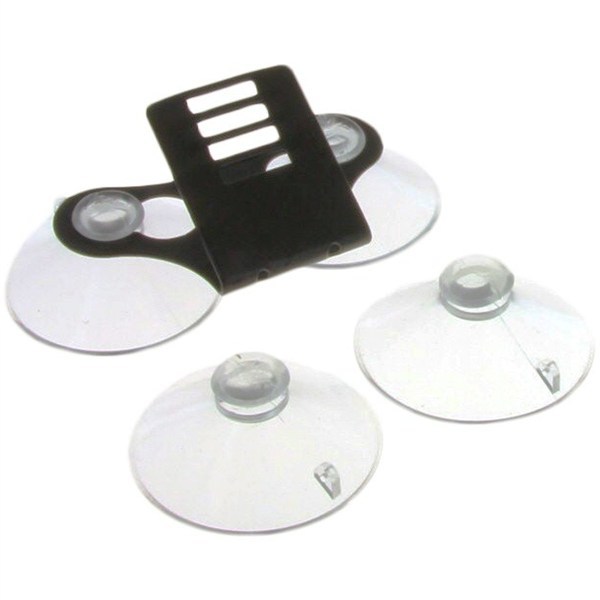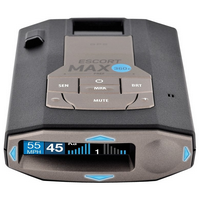

Escort fairly recently changed the type of suction cup that they ship with some of their higher end radar detectors. What was once a small, traditional metal bracket with two suction cups is now a larger bracket with a single large, prominent, Sticky Cup. The Escort Max, Max2 and the new Beltronics GT-7 all include this new Sticky Cup.
The Sticky Cup is more than just a windshield mount with a super sized suction cup. It is literally sticky, hence the name "Sticky Cup". The cup itself has a sort of sticky, gummy surface on the suction side, presumably to help it grab the windshield glass better.
And grab the glass it does. Once the paper backing is removed from the sticky area and the cup is placed in the desired position, it's a simple matter of closing the locking clamp to create the suction in the cup and seal it tight to the windshield.
Not surprisingly, the Sticky Cup can handle the weight of the premium Escort and Beltronics detectors. Since the suction cup itself is considerably larger and "stickier" than the small, clear cups included with the standard metal windshield bracket, that is certainly to be expected. It is also quite adjustable. There is a large knob on the side of the bracket allows you to rotate the bracket on the mount to position the radar detector at the desired angle.
The Sticky Cup does seem to have a lot to offer in comparison to the old, standard radar detector mount, and at first glance one would think it is far superior in every way. However, it does have some drawbacks, a few which may put the plain, two cup mount back into consideration.
Consider this.
The Escort Sticky Cup is large. It is also a solid, completely opaque black. this makes the Sticky Cup a lot more noticeable. Some may consider the Sticky Cup a little too big to be discreet at all. The standard metal brackets are small, and the dual suction cups are clear or translucent. This type of bracket is not as noticeable on a windshield as the Sticky Cup.
The Sticky Cup is one single cup. Unlike the standard mounts, which typically have two suction cups, the Escort Sticky Cup is completely on its own. Why is it something to consider? Well, consider this. Any suction cup can lose suction from time to time. It just happens. If it happens to a two cup mount, there is a chance they may go one at a time, which gives you time to catch it first and instantly re-mount it before everything falls down.
However, when the Sticky Cup goes, there is nothing to hold it back. You can't count on the sticky surface of the cup to delay it. The stickiness just isn't sticky enough to counter the weight. When it falls, It just falls, and everything, the cup, the mount and the detector, falls with it. You simply won't have time to react.
Adjusting the Sticky Cup is easy, but it is somewhat limited. The big plastic knob is certainly better for adjusting the angle of your radar detector. Simply loosen the knob, tilt the detector, and tighten the know again. There is one limitation. It adjusts in steps. They are very small steps, to be sure, but they are still set increments.
In contrast, the standard metal windshield mount can easily and instantly be bent to the degree desired, without loosening or tightening something in the process. Simply bend the mount exactly to the angle you want, and let go. You're done.
Removal of the Sticky Cup can take longer than the removal of a standard two cup mount. Taking the Sticky Cup off a windshield is a two step process. First, the locking clamp must be released, which can be a bit cumbersome to get to if the radar detector is mounted at an angle that obstructs your access to the clamp and if you have big fingers. After the clamp is unlocked, you must pull the tab at the rim of the cup to release the suction and remove the mount.
To release a standard two cup mount, simply grab the edges of the cups with your fingers and lift them from the surface of the windshield. With a little practice, this can be accomplished in one deft move. Such speed may be necessary if, say, you are pulled over in a jurisdiction where radar detectors are illegal (Virginia and Washington, D.C.) and you quickly want to hide it away from view.
The Sticky Cup is sticky. It can be seen as an advantage over a regular two cup mount, but it can also be a disadvantage. Sticky surfaces tend to pick up dirt, dust and other artifacts very easily, which can severely limit or completely hinder the ability of the cup to stick to anything at all. According to the instructions, the Sticky Cup can be rinsed under warm water to clean it off, but care must be taken to keep the dirt at a minimum.
The standard two cup detector mount, on the other hand, can be cleaned with a simple wipe down, if needed. Since the little cups on these mounts are usually smooth and not sticky, in most cases, a cleaning it isn't even needed.
The Sticky Cup costs more. the Escort Sticky Cup mount sells for $29.95. While it's not the most expensive mount on the market, it is a premium, to be sure.
The Bel Pro / Escort Windshield Mounting Bracket is about half that price, at $14.95.
The best deal of all is the XLT Brand Windshield Mounting Bracket for Beltronics / Escort Radar Detectors. it includes a second pair of suction cups as part of the package. Plus, it comes with free shipping. This one is a real bargain. It's only $6.99.
If you want a premium mount for your Escort or Beltronics radar detector that supports it, and you don't mind the caveats, then the Escort Sticky Cup may be the mount for you. Before you choose, consider it from every angle, not just the one posted for the product. We want you to be satisfied with your purchase.






